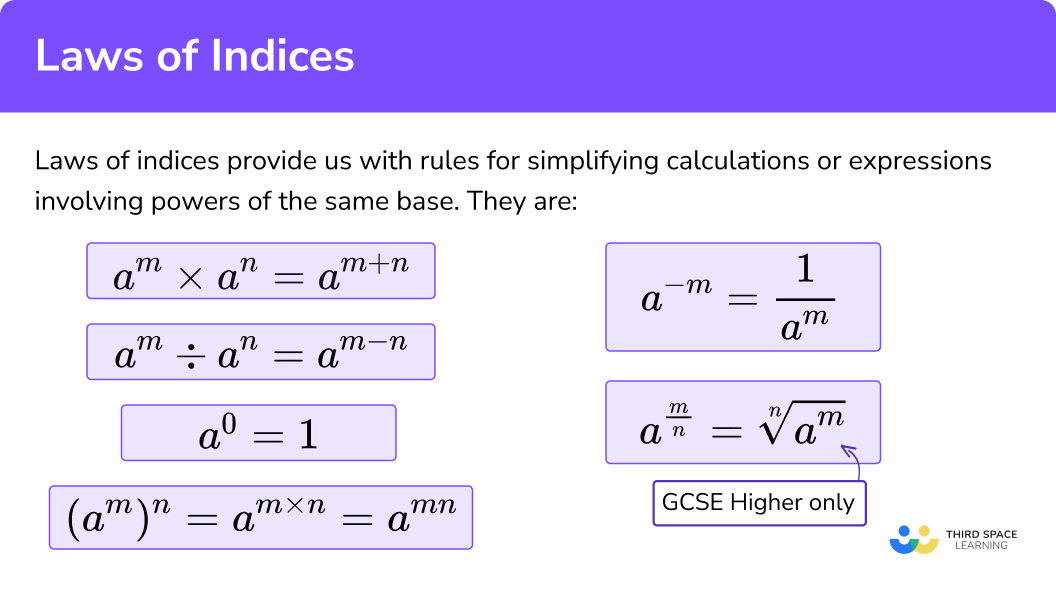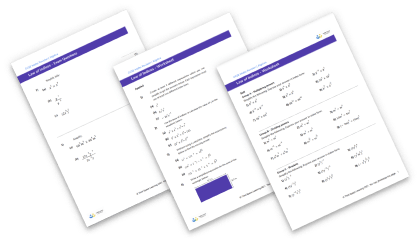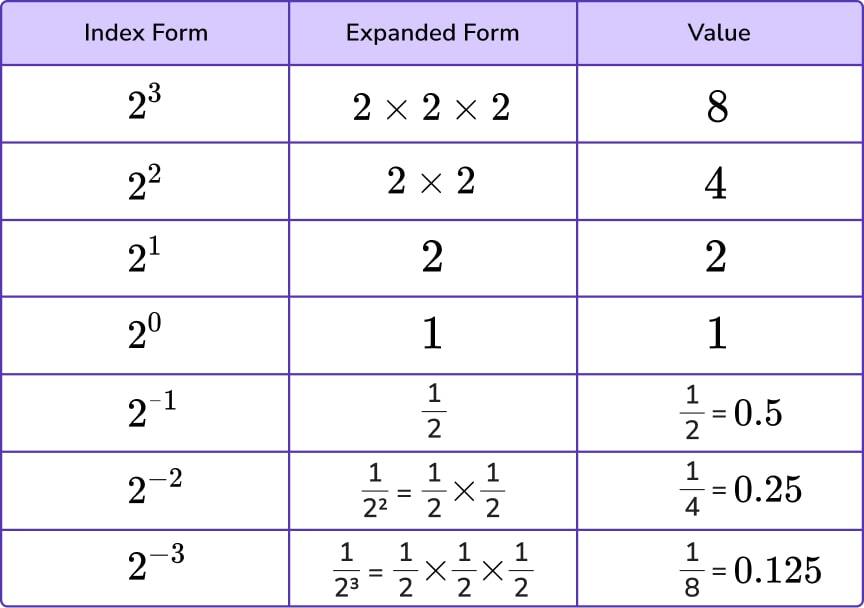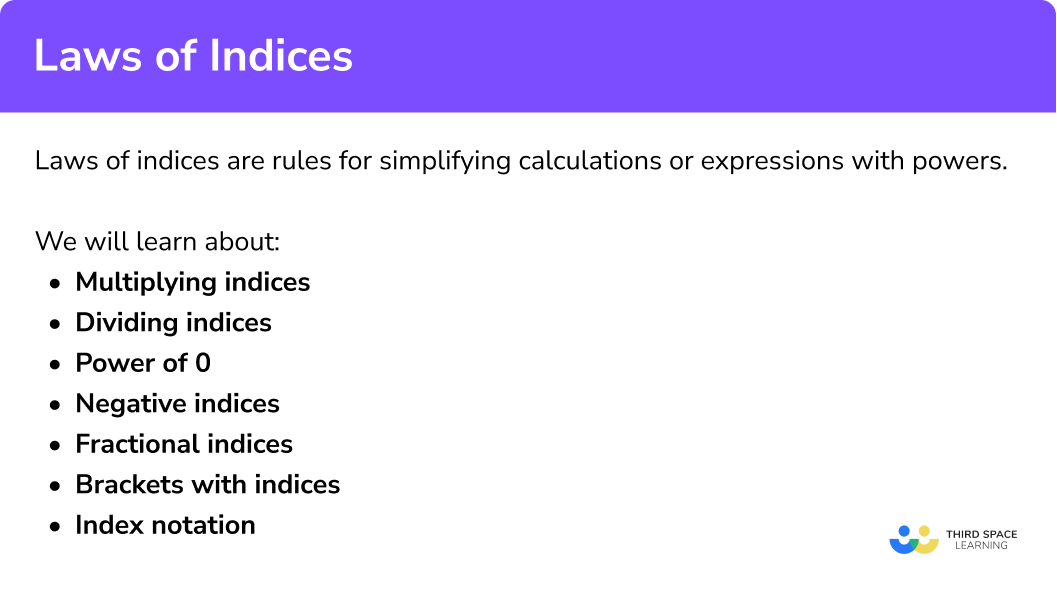GCSE Tutoring Programme
Our chosen students improved 1.19 of a grade on average - 0.45 more than those who didn't have the tutoring.
In order to access this I need to be confident with:
Negative numbers Arithmetic Fractions to decimalsThis topic is relevant for:

Laws of Indices
Here we will learn everything you need to know about the laws of indices for GCSE & iGCSE maths (Edexcel, AQA and OCR). You’ll learn what the laws of indices are and how we can use them. You’ll learn how to multiply indices, divide indices, use brackets and indices, how to raise values to the power of 0 and to the power of 1, as well as fractional and negative indices.
Look out for the index laws worksheet and exam questions at the end.
What are the laws of indices?
Laws of indices provide us with rules for simplifying calculations or expressions involving powers of the same base. This means that the larger number or letter must be the same.
For example,
We cannot use laws of indices to evaluate calculations when the bases are different
For example,
We can however evaluate these calculations. Check out our other pages to find out how.
What are the laws of indices?

What are the 6 laws of indices?
The 6 laws of indices are:
- Multiplying indices
- Dividing indicies
- Brackets with indices
- Power of 0
- Negative indices
- Fractional indices
For examples and practice questions on each of the rules of indices, as well as how to evaluate calculations with indices with different bases, follow the links below.
See also: Index notation

Index laws worksheet

Get your free laws of indices worksheet of 20+ questions and answers. Includes reasoning and applied questions.
DOWNLOAD FREE
Index laws worksheet

Get your free laws of indices worksheet of 20+ questions and answers. Includes reasoning and applied questions.
DOWNLOAD FREELaws of indices methods
Law 1: Multiplying indices
When multiplying indices with the same base, add the powers.
Step-by-step guide: Multiplying indices
Law 2: Dividing indices
When dividing indices with the same base, subtract the powers.
Step-by-step guide: Dividing indices
Law 3: Brackets with indices
When there is a power outside the bracket multiply the powers.
Step-by-step guide: Brackets with indices
Law 4: Power of 0
Any non-zero value raised to the power of 0 is equal to 1.
Step-by-step guide: Power of 0
Law 5: Negative indices
When the index is negative, put it over 1 and flip (write its reciprocal) to make it positive.
Step-by-step guide: Negative indices
Law 6: Fractional indices
When the index is a fraction, the denominator is the root of the number or letter, then raise the answer to the power of the numerator.
Step-by-step guide: Fractional indices
What are indices?
An index is a small number that tells us how many times a term has been multiplied by itself.
The plural of index is indices.
Below is an example of a term written in index form:
4 is the base and 3 is the index.
We can read this as ‘4 to the power 3’
Another way of expressing 43 is
Indices can be positive or negative numbers.

Moving up the rows we get 2 times larger per row.
Moving down the rows we get 2 times smaller per row.
Calculations with indices
In order to calculate with indices we need to be able to use the laws of indices in a variety of different ways. Let’s look at the different ways we can calculate with indices.
How to use the laws of indices
We can use the laws of indices to simplify expressions.
Explain how to use the laws of indices

Law 1: multiplying indices
When multiplying indices with the same base, add the powers.
1 Add the powers.
2 Multiply any coefficients.
…………………………………………………………………………………………………………………………………………………….
Example
Simplify
This can be written as
1 Add together the indices 3 and the 2.
2 Multiply 4 and 7 together.
So,
Law 2: dividing indices
When dividing indices with the same base, subtract the powers.
- Subtract the indices.
- Divide any coefficients of the base number or letter.
…………………………………………………………………………………………………………………….………………………………
Example
Simplify
Subtract the indices 9 and 2.
Divide the coefficients 21 and 7.
So,
Law 3: brackets with indices
When there is a power outside the bracket multiply the powers.
- Multiply the indices.
- Raise all coefficients inside the bracket to the power outside the bracket.
Why does this work?
Let’s look at
This algebraic expression has been raised to the power of 4, which means:
We know when we multiply indices with the same base, we must add the powers.
Is there a quicker way to work this out?
Simplifying
When we have brackets and indices we can multiply the powers.
Brackets with indices examples
Example 1: no coefficient in front of base
Simplify and leave your answer in index form.
Multiply the powers 3 and the 4.
So,
Example 2: coefficient inside bracket
Simplify and leave your answer in index form.
Multiply the indices 3 and the 2.
Raise 10 to the power of 2.
So,
Example 3: negative indices
Simplify and leave your answer in index form.
Multiply the indices -3 and the 2.
Raise -4 to the power of 2.
So,
Law 4: power of 0
Any non-zero value raised to the power of 0 is equal to 1.
Example
Simplify
We can see that
Multiplying anything by 1 leaves it unchanged, this is called the multiplicative identity.
So,
Law 5: negative indices
When the index is negative, put it over 1 and flip to make it positive.
- Put the term over 1.
- Flip the fraction to make the index positive.
- Simplify if necessary.
Example
Simplify
Notice how the index affects the entire bracket
Put the term over 1.
Flip and change the power -3 to +3.
Simplify the denominator.
So,
Law 6: fractional indices (H)
When the index is a fraction, the denominator is the root of the number or letter, then raise the answer to the power of the numerator.
- Use the denominator to find the root of the term
- Raise the answer to the power of the numerator
Example
Evaluate
Use the denominator to find the cube root of the number or letter.
Raise the answer to the power of the numerator.
So,
Common misconceptions
- The multiplication and division laws can only be used for terms with the same base
You cannot simplify
as the bases are different
- When a power is outside the bracket you must raise all terms inside the bracket by that power
E.g.
When we simplify
We must remember to square both the 4 and the a. It is common to forget to square the 4.
The brackets mean the entire term is squared.
- Confusing integer and fractional powers
Raising a term to the power of 2 means we square it
E.g.
Raising a term to the power of ½ means we find the square root of it
E.g.
Raising a term to the power of 3 means we cube it
E.g.
Raising a term to the power of ⅓ means we find the cube root of it
E.g.
- Confusing positive and negative powers
We can have decimal, fractional, negative or positive integers.
- Indices, powers or exponents
Indices can also be called powers or exponents.
Practice laws of indices questions
1. Simplify
4 a^{6} \times 5 a^{-2}




We need to multiply the coefficients
4\times5=20
Since the base number is the same in each term, we can add the indices
6+(-2)=4
This means
4 a^{6} \times 5 a^{-2}=20 a^{4}
2. Simplify
-3 a^{4 b} \times 6 a^{7 b}




We need to multiply the coefficients
-3\times6=-18
Since the base number is the same in each term, we can add the indices
4b+7b=11b
This means
-3 a^{4 b} \times 6 a^{7 b}=-18 a^{11 b}
3. Simplify
20 b^{10} \div 4 b^{5}




We need to multiply the coefficients
20\div4=5
Since the base number is the same in each term, we can subtract the indices
10-5=5
This means
20 b^{10} \div 4 b^{5}=5 b^{5}
4. Simplify
42a^{-3} \div 6 a^{-8}




We need to divide the coefficients
42\div6=7
Since the base number is the same in each term, we can subtract the indices
-3- \,-8=-3+8=5
This means
42a^{-3} \div 6 a^{-8}=7 a^{5}
5. Simplify
(32 x)^{0} \times 6^{2}




Anything raised to the power zero is 1 , so
(32 x)^{0}=1
This means we have
1\times6^{2}=1\times36=36
6. Simplify
(5 x)^{-3}




The negative index number indicates we need the reciprocal of
(5x)^{3}
Since
5x^{3}=5x\times5x\times5x=125x^{3}
We have
(5 x)^{-3}=\frac{1}{125 x^{3}}
7. Simplify
6 b^{-4}




The negative index number indicates we need the reciprocal of
b^{4}
The index number does not affect the 6 , hence
6 b^{-4}=\frac{6}{b^{4}}
8. Evaluate
64^{\frac{2}{3}}




The index number is telling us to square the cube root, so
64^{\frac{2}{3}}=(\sqrt[3]{64})^{2}=4^{2}=16
9. Evaluate
16^{-\frac{1}{2}}




The index number is telling us to find the reciprocal of the square root, so
\begin{aligned} &16^{-\frac{1}{2}}\\ &=\frac{1}{16^{\frac{1}{2}}}\\ &=\frac{1}{\sqrt{16}}\\ &=\frac{1}{4} \end{aligned}
Laws of indices GCSE questions
1. Simplify
\frac{p^{7}}{p^{3}}
(1 mark)
p^{4}
(1)
2. Simplify
6 h^{3} m^{6} \times 4 h^{4} m^{5}
(2 marks)
h^{7} \text { or } m^{11} seen (evidence of adding powers)
(1)
24 h^{7} m^{11}
(1)
3. Simplify
\frac{12 x^{5} y^{7}}{3 x^{2} y}
(2 marks)
x^{3} \text { or } y^{6} seen (evidence of subtracting powers)
(1)
4 x^{3} y^{6}
(1)
Learning checklist
You have now learned how to:
- Simplify expressions involving the laws of indices
- Calculate with roots, and with integer and fractional indices
The next lessons are
Still stuck?
Prepare your KS4 students for maths GCSEs success with Third Space Learning. Weekly online one to one GCSE maths revision lessons delivered by expert maths tutors.

Find out more about our GCSE maths tuition programme.